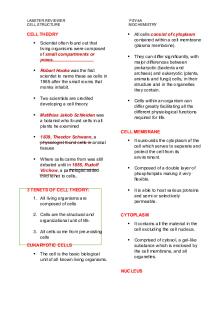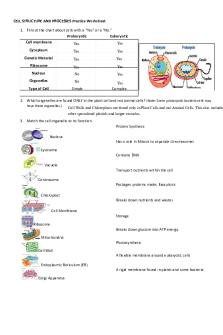Prokaryotic Cell Structure PDF

| Title | Prokaryotic Cell Structure |
|---|---|
| Course | Foundations of Biological Sciences I |
| Institution | University of Wisconsin-Milwaukee |
| Pages | 4 |
| File Size | 85.2 KB |
| File Type | |
| Total Downloads | 10 |
| Total Views | 140 |
Summary
Prokaryotic Cell Structure...
Description
Cell structure I. Prokaryotic Cells A. Importance of being small Prokaryotes are usually small (usually 0.5-2 um in diameter.). Eukaryotic cells are larger, usually 5-50 um diameter Small size of prokaryotes is an advantage when it comes to utilizing scarce nutrients. Transport of nutrients is related to membrane surface area Smaller cells have more surface area with respect to volume Therefore smaller cells can utilize scarce nutrients more rapidly This results in faster growth rates and larger populations.
B. Anatomy of a Bacterial Cell 1. Cytoplasm DNA RNA Ribosomes (70s, contrast with 80s of eukaryotes) Soluble proteins Small molecules (monomers, salts, etc.) Some prokaryotes have gas vesicles to help in buoyancy Storage Inclusions include glycogen (sugar storage) polyphosphate (P storage) Sulfur granules 2. Cytoplasmic membrane phospholipid bilayer with protein embedded within it or associated with it. Integral membrane proteins in the cytoplasmic membrane usually have one or more hydrophobic helices that span the membrane and anchor the protein in the membrane. Peripheral membrane proteins are associated with the membrane but can be easily removed. These proteins do not span the lipid bilayer. Functions of the cytoplasmic membrane: -Barrier: hold cytoplasm and keeps cell contents from leaking to outside keep unwanted stuff outside -Membrane displays selective permeability- does not allow everything into the cell
-Many enzymes of metabolism in membrane (for generation of ‘proton motive force’ and ATP)
3. Cell wall Functions: 1. give cell shape 2. prevent osmotic lysis Main component is peptidoglycan (PG) Peptidoglycan is made of 1. Sugars: N-acetyl muramic acid (NAM), N-acetyl glucosamine (NAG) 2. D and L amino acids 3. diaminopimelic acid (N-acetyl muramic acid, D amino acids and diaminopimelic acid are not commonly found elsewhere in nature. Unique to peptidoglycan.) lysozyme cleaves peptidoglycan between sugar residues penicillin prevents amino acid cross bridge formation a. Gram+ cell wall Gram + cell wall has thick layer of PG (up to 25 layers thick) b. Gram negative cell wall Gram-negative cell wall consists of a thin layer of PG (1 or 2 layers thick) and an outer membrane (OM) Gram negative outer membrane (OM): Composition: -lipid bilayer with proteins embedded -phospholipids make up inner leaflet of OM -Lipopolysaccharide (LPS, or endotoxin) constitutes the bulk of the outer face of the OM -porins are proteins that form pores in the outer membrane functions: -exclude some toxins, -evade phagocytosis,
periplasm- space between cytoplasmic and outer membrane of Gram-negative cells and peptidoglycan and cytoplasmic membrane in Gram-positive cells.
4. Capsule or slime layer - viscous polymer that is made of polysaccharides, peptides, or both. Functions: -protect cell from drying -protect cell from phagocytosis -allow cells to stick to surfaces
5. Bacterial Flagella Structure: -long rigid propellers that extend from the cell -bulk of the structure is composed of multiple copies of the protein flagellin -basal body in the cell envelope composed of many different proteins anchors the flagellum to the cell Function: -Rotation of the flagellum results in cell movement -basal body is the motor that turns the flagellum -proton motive force is the energy source used by this motor A cell may have a single flagellum or many flagella Bacterial cells can sense environmental stimuli and will respond by the process of chemotaxis. Stimulus can be nutrients, O2, light, etc. E. coli uses two behaviors (‘runs’ and ‘tumbles’). CCW flagellar rotation results in a run. A switch to CW rotation disperses the bundle and causes a tumble. Cells can detect concentrations of stimulus and increase time of runs 6. Pili or Fimbriae- long filamentous structures composed of protein that extend from the cell Functions: -involved in attachment to surfaces -some pili involved in DNA transfer by conjugation -some pili involved in twitching motility (unrelated to bacterial flagellar motility) -pili are one type of 'virulence factor’-(feature that results in ability to cause disease)
C. Archaeal Cell structure Similar in gross appearance to Bacterial cells, but have major differences: 1. Unusual lipids make up Archaeal membranes 2. Archaeal cell walls do not have peptidoglycan therefore lysozyme and penicillin have no effect on archaea (fortunately no Archaea are known to be human pathogens) 3. Machinery of DNA replication and transcription are more similar to those of eukaryotes than to those of bacteria. 4. Other unique features of archaea Many have unique metabolism (methanogens) Many live in harsh environments (halophiles, hyperthermophiles)...
Similar Free PDFs

Prokaryotic Cell Structure
- 4 Pages

Prokaryotic
- 5 Pages

Cell Structure SE 1
- 3 Pages

Labster 1 cell structure
- 10 Pages

Cell Structure (reviewer)
- 7 Pages

Structure of generalized cell
- 2 Pages

Cell Structure Worksheet
- 1 Pages

Cell Structure notes
- 13 Pages

Cell Structure Practice
- 3 Pages

CELL Structure OF Microorganisms
- 7 Pages

Cell Structure worksheet
- 3 Pages

1.b Cell Structure Worksheet
- 1 Pages

IB 1108 L10 Cell Structure
- 4 Pages

Cell Structure and Magnification PPQ
- 28 Pages
Popular Institutions
- Tinajero National High School - Annex
- Politeknik Caltex Riau
- Yokohama City University
- SGT University
- University of Al-Qadisiyah
- Divine Word College of Vigan
- Techniek College Rotterdam
- Universidade de Santiago
- Universiti Teknologi MARA Cawangan Johor Kampus Pasir Gudang
- Poltekkes Kemenkes Yogyakarta
- Baguio City National High School
- Colegio san marcos
- preparatoria uno
- Centro de Bachillerato Tecnológico Industrial y de Servicios No. 107
- Dalian Maritime University
- Quang Trung Secondary School
- Colegio Tecnológico en Informática
- Corporación Regional de Educación Superior
- Grupo CEDVA
- Dar Al Uloom University
- Centro de Estudios Preuniversitarios de la Universidad Nacional de Ingeniería
- 上智大学
- Aakash International School, Nuna Majara
- San Felipe Neri Catholic School
- Kang Chiao International School - New Taipei City
- Misamis Occidental National High School
- Institución Educativa Escuela Normal Juan Ladrilleros
- Kolehiyo ng Pantukan
- Batanes State College
- Instituto Continental
- Sekolah Menengah Kejuruan Kesehatan Kaltara (Tarakan)
- Colegio de La Inmaculada Concepcion - Cebu

